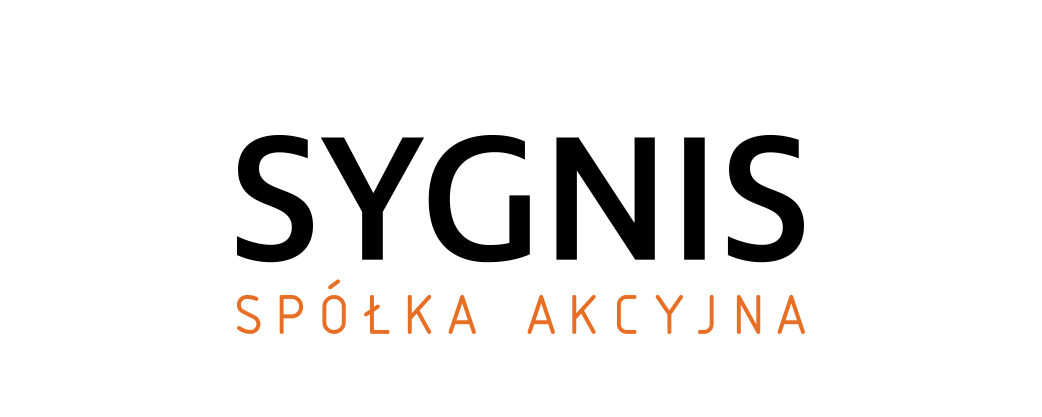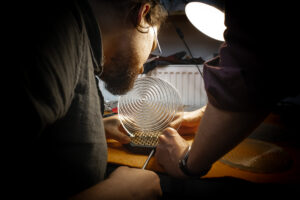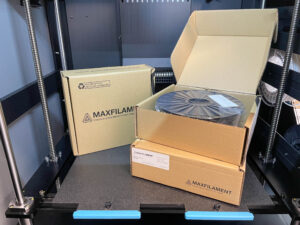Silk spinning is one of the oldest techniques of producing textile materials known to humankind. Traces of its use were found in ancient China three and a half thousand years before the birth of Christ, according to archaeologists. The silk is obtained from cocoons produced by mulberry silkworms – a specific species of a moth. Silk fibers can be converted into a distinctive fabric of outstanding performance and high esthetic value. The silk fabric is both smooth and delicate, as well as a characteristically lightweight material. Its high strength also allows silk to be used for the production of surgical sutures.
The Silk Road
The transport of silk from China to Europe and the regions of the Middle East determined the development of the famous trade route, over 12 thousand kilometers long, called the Silk Road. This route was functioning from the 3rd century BC to approximately the 17th century AD, till it lost its importance due to the discovery of the sea route to China.

source: http://www.paintingschinese.com/painting-preview.asp?s=BR-0362
Fabrics obtained from silk fibers have been adapted in many different cultures along the Silk Road. In China, this material was used for the production of ritual robes and as a base for painting, in Japan, kimono belts – obi – were sewn from silk.
Silk was, and still is, widely used in religious practices around the world – the pallium is a woollen ribbon worn by the Pope, on which crosses are sewn with black silk; in Judaism, however, Jews wear a special silk prayer shawl – tallit. Islam embroider the wording of the Koran on pieces of black silk with a golden thread.
Playing mother nature
The production of silk, though it’s been known for many centuries, still arouses admiration. Many insects are able to produce silk fibers, which represent a vast class of proteins that are structurally related to each other.
The most commonly used in the textile industry are silk cocoons produced by Bombyx mori due to its elegant, shiny appearance and incredible durability.
For years, scientists who have been looking for a 3D printing method of silk fibers and wondered about the extraordinary strength and the high mechanical resistance of the silk fiber.
Silk spinning is a high-class material sourcing solution provided by evolution. This inspired scientists to adapt nature’s strategy to the industrial production of polymers [1] – at least in theory. In practice, it remains inaccessible due to the fundamentally different mechanisms of material production, especially at the molecular level, between the biological and synthetic processes.
[1] Polymers are chemical substances of very high molecular weight that consists of repeating units called mers.
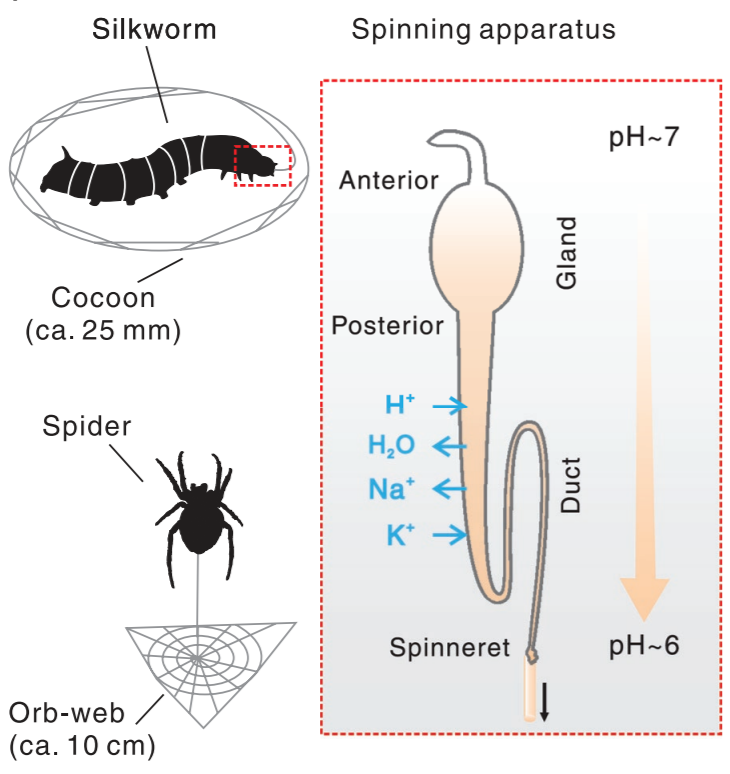
The distinguishing features of silk-spinning are the efficient acquisition of protein material, water treatment of fibers and unique properties of the material, regardless of its form.
There has been significant progress in industrial silk spinning, but in the scientific sphere, there are still unresolved issues. Currently, the scientific world is trying to develop a technical framework for the construction of high-performance silk structures at the molecular level. The main challenge remains the artificially induced spinning of fibers and 3D printing of silk composites.
Silk spinning is a biomimetic [2] model of advanced and efficient production of artificial polymer, which brings with it the possibility of application in innovative biomedical techniques, such as tissue scaffolds [3] or implantable devices.
[2] Imitating biological processes.
[3] Micro-scaffold supporting cell cultivating in biotechnology.
From the spinneret to the lab
Leaving aside the historical implications of silk as a luxury fabric, the world recognizes its advantages also in terms of scientific use. Classified as a biomaterial with extraordinary performance and mechanical resistance, ranking higher than most natural and synthetic polymers. Especially the fibers from silk spiders are characterized by extraordinary tensile strength – ≈160 J · g − 1 – for comparison, this parameter for polyester oscillates around ≈50 J · g −1. Only a few of artificial polymers managed to surpass the strength of silk – one of them is graphene oxide nanotubes – 1000 J · g − 1.
Therefore, silk-like materials conquer various areas of life, ranging from sports equipment, through polymer-reinforced composites, ending with biotechnology. Moreover, silk is biocompatible and biodegradable, especially when compared with most petroleum-based, synthetic materials. Silk consists of blocks of amino acids – this structure supports proteinase degradation [4] and in vivo compatibility [5] in terms of reduced inflammation, poor immune response and low blood coagulability levels, all desirable features for biomaterials.
The properties of silk make it one of the most unusual materials available to humankind, but the spinning process itself seems to be even more valuable to science. Combined with a unique chemical formula and protein sequence, silk spinning is also energy-efficient and environmentally harmless, which significantly distinguishes this process from other industrial production mechanisms. Minimal energy consumption is due to the evolution driven will to survive in nature – silk spinning is almost 90% more energy-efficient than processing polyethylene at high-density of 125°C.
Silk spinning inspired various and significant manufacturing efforts using regenerated silk proteins and even other polymers. In order to translate silk-spinning into synthetic production, it is important to understand the basic mechanisms at the molecular level. A group of scientists from Tufts University in the US looked at the properties of silk fibers of natural origin, from both mulberry silkworm and silk spiders. The parameters that were compered were the molecular weight of the proteins used, the structure of amino acids, liquid-crystal phases and rheological behavior, pH of the fibers and the content of salt ions, as well as naturally occurring mechanical forces accompanying the spinning process. Then, these parameters were compared with the results obtained during the synthetic silk-spinning test. These results allowed to develop the most optimal conditions for synthetic silk spinning in the 3D printing technique.
[4] Cellular proteolysis, i.e. the process of cell digestion; it leads to the breakdown of harmful proteins in the cell into peptides and amino acids.
[5] latin for within the living.
The duet we were waiting for? Silk fiber and 3D printing romance
3D printing has an advantage over traditional production methods in terms of obtaining sophisticated material geometries and precise space management. It has been applied to a wide range of polymers and materials such as thermoplastics, photo-curable resins, aluminum alloy, liquid crystal polymers, optically transparent glass, hydrogels such as the extracellular matrix (collagen) and synthetic polymers. It comes with no surprise then, that the natural course of events turned 3D printing technology towards silk fibers.
For starters, it is interesting to note that the silk spinning process is basically quite similar to the extrusive [6] 3D printing technology. Silk fibers as structural elements create three-dimensional structures such as cobwebs and cocoons – spider webs consist of various silk fibers from separate salivary glands, which is a natural version of multi-material 3D printing systems. Therefore, it is logical and promising to translate the mechanisms and techniques of silk-spinning into 3D printing processes and take advantage of a number of applications, from tissue engineering scaffolds to intelligent devices.
Native admixtures of silk inspired the development of concentrated polyelectrolyte [7] inks for 3D printing. As interesting as it sounds, 3D silk printing, like any other collagen/gelatin containing material, is severely limited due to its low structural integrity and mechanical performance compared to their natural equivalents. Therefore, there is a need for the construction of structural reinforcements, often using artificial auxiliary materials.
[6] Extrusion – a type of plastic processing – the material flows out through the hole or holes in the tool under the pressure of a stamp.
[7] Polyelectrolytes are polymers whose repeating units – “mers” have a group of electrolytes.
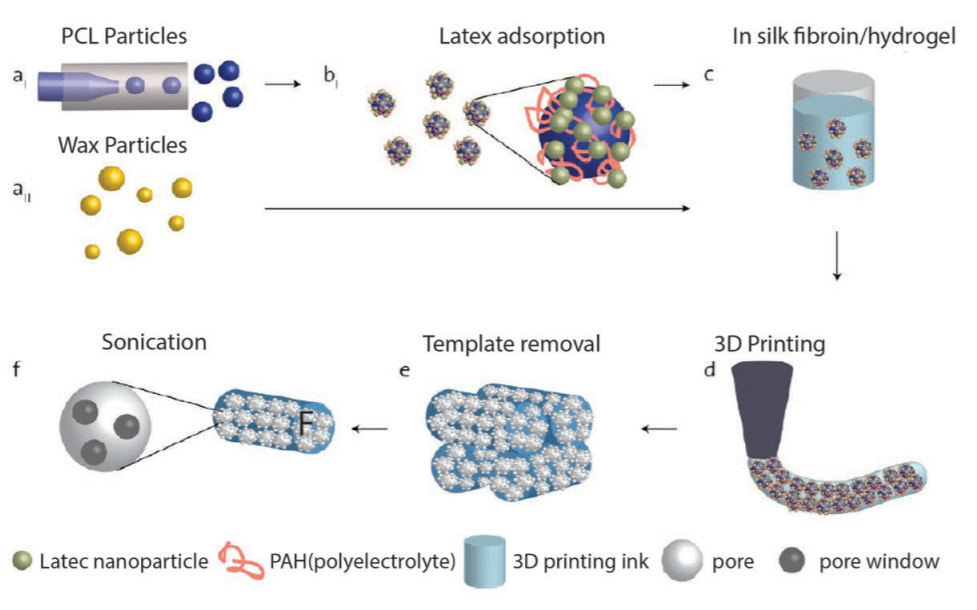
Nevertheless, protein silk inks have been developed for use in 3D printing. Most of them are prepared by combining a silk raw material with a structural element to increase the printing possibilities. So far, 3D printing from a 100% silk protein material has only been achieved by a few technologies.
Third for pair
The most common method of 3D printing silk fibers by extrusion technology is combining silk with another solution/material that strengthens the print structure, including the use of agar, gelatin, PEG, glycerol or Konjac gum. The admixtures usually increase the viscosity and thus improve the rheological properties [8] of silk inks composite, which helps to maintain the shape of the printed structures. This approach may prove to be physiologically important because many living tissues show a composite structure, including bones, cartilage, ligaments, tendons and skin.
However, silk composite inks can also contain cellular material to construct 3D structures filled with cells. In particular, bioinks made of silk / PEG combination were used to print various tissue constructions with high resolution and uniformity.
In addition, a specific concentration of the silk solution (10 m / m) facilitated cell growth, suggesting that this particular bio gel – silk / PEG – can provide adequate structure and strength for the production of scaffolds for cell printing.
Silk materials in the form of fibers or particles are useful as reinforcements for other materials used in 3D printing. The integration of silk particles in the 3D printed chitin hydrogel – a compound derived from chitin, building material of the external skeleton of arthropods – gave a five-fold higher result for the modulus of elasticity. Similarly, the integration of silk micro and nanofibers in chitin hydrogels significantly increased the efficiency of the mechanical properties of printed structures without including cytotoxicity [9] to human fibroblasts [10]. Silk microfibers and nanofibers can be used as reinforcements for silk hydrogels, and potential applications can also be found in 3D printing of monolithic silk structures.
[8] Rheology describes an aspect of the behavior of solids in which they become like a viscous liquid.
[9] Cytotoxicity is the widely understood toxicity of various substances to cells in an organism.
[10] Fibroblasts – cells found in animals and humans, which are the most numerous cells of the connective tissue.
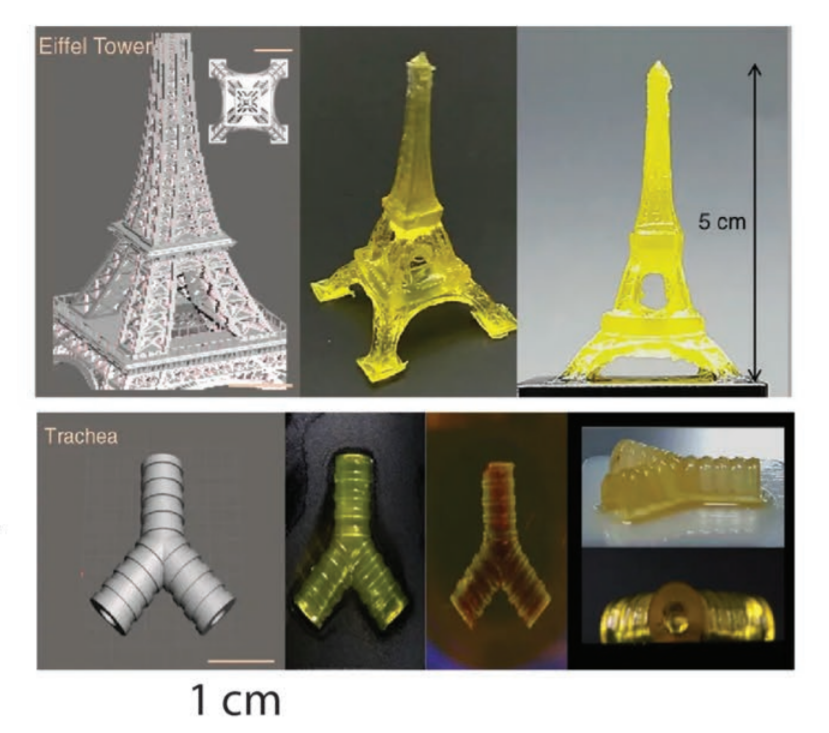
In addition to combining structure-supporting materials with silk, silk proteins can be photopolymerized with light-based 3D printing technology. Digital light processing has been developed to shape silk into complex structures, including e.g. tracheas, but also mini models, such as the Eiffel Tower.
Veni, vidi, vici?
Pure silk was used for the first time in 3D printing technology based on the form of fibers (concentration 28% -30%). This was achieved by combining the advanced spinning infrastructure of 3D extrusion printing and the widely used methanol solvent (85%). The most important element in the whole process seems to be the printer base, on which direct printing allows for high resolution of printed silk filaments with a diameter of only 5 µm. Printed with 3D printing technology, silk scaffolds naturally take over the properties of silk proteins to, for example, regenerate bone tissue, and thus strengthen adhesion [11] and natural growth, for example, of bone marrow obtained from stem cells!
Let us return to the aforementioned group of scientists from Tufts University in the USA engaged in research on artificial silk spinning. Researchers attempted to develop a novel method of combining the spinning process and 3D printing. To begin with, to replace the methanol bath and generate 3D prints with adequate mechanical and geometric strength, the group used as a model a silk spinning mechanism where pH, salt ions and dehydration are used together in a systematic manner to control the phase transition (solidification and gelling) of silk proteins. Although the exact properties of the solvent in vivo remain unclear, a water bath has been developed with a de novo chemical composition [12] rationally adapted to 3D printed pure silk proteins. The water bath contained 0.5 m of dipotassium phosphate and 4 m of sodium chloride. These salt ions occur naturally in the silkworm glands and have a specific salt effect on silk proteins. Phosphate ions create a slightly acidic environment (pH ≈ 6) that mimics the anterior part of the gland. High salt concentration ensures high osmolarity [13] (> 8 m when one molecule of sodium chloride breaks down into two ions) – a similar process occurs in the case of dehydration in animals. The water bath is thus “biomimetic” and recapitulates [14] the cell-regulated complex and dynamic properties of the solvent in the native spinneret glands.
[11] Adhesion is the phenomenon of joining the surface layers of two different bodies in contact with each other.
[12] Latin expression for ‘from the beginning’, ‘anew’.
[13] Osmolarity – the number of moles of osmotically active substances in 1 liter of solution.
[14] Recapitulates – sums up.
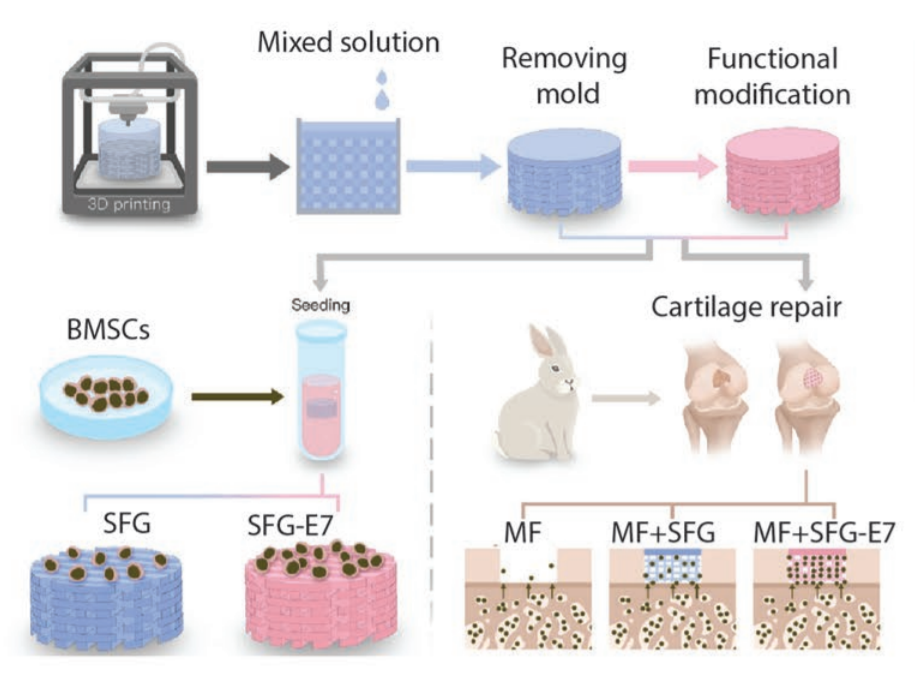
This biomimetic bath was used to efficiently 3D print silk proteins. In particular were printed overhanging filaments with a length of 30 mm and a diameter of 85 um, mechanically supported only at the ends. Therefore, the dynamics of solidifying the ink must be fast in order to prevent it from oozing, thus imposing strict requirements on the printing process.
The US group, therefore, proved that 3D printing of silk fibroin by directed molecular assembly implies a new paradigm for 3D biodegradation.
What’s next? – plans for the future
Biomimetic silk-spinning study places more weight on processing than on the structure itself. Thus, the basic scientific principles of silk-spinning can be withdrawn from the observed relationships between processing, structure and function. The processing advantages of silk-spinning are particularly desirable and worth emulating in the industrial production of polymers. Moreover, silk spinning is the embodiment of sustainable production and can be considered as “living” nanotechnology. The hierarchical assembly of molecules has been approximated in artificial systems, but there is still much to be achieved in the mechanical advantage of biodegradable silk fibers over other materials. Thanks to good process control and easy approaches, they can be applied on a larger scale and even industrialized.
In addition, despite some effort to mimic the water conditions during silk spinning, simplified engineering systems imitating naturally complex biological systems required creative solutions. Overall, future research will need to combine mechanistic research using various biotechnology tools, computational modelling, microfluidic technology [15] and 3D printing with integral engineering platforms that exploit the benefits of silk proteins and the spinning process.
[15] Microfluidic refers to the behavior, precise control, and manipulation of fluids that are geometrically limited to a small scale.
Source: https://onlinelibrary.wiley.com/doi/full/10.1002/adhm.201901552

